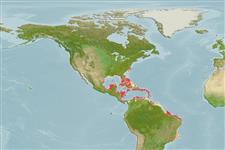>
Eupercaria/misc (Various families in series Eupercaria) >
Labridae (Wrasses) > Corinae
Etymology: Halichoeres: Greek, als, alis = salt + Greek, choiros = pig (Ref. 45335).
More on author: Bloch.
Environment: milieu / Klimaatzone / Diepte / distribution range
Ecologie
marien rifbewoner; diepte 1 - 15 m (Ref. 9710). Tropical; 37°N - 26°S, 100°W - 28°W
Western Atlantic: North Carolina, USA and Bermuda to Brazil (Ref. 7251).
Grootte / Gewicht / Leeftijd
Maturiteit: Lm ? range ? - ? cm
Max length : 35.0 cm TL mannelijk / geslacht onbekend; (Ref. 55367); max. gepubliceerd gewicht: 146.00 g (Ref. 9626)
Dorsale stekels (totaal) : 9; Anale stekels: 3; Anale zachte stralen: 12. The dominant color markings are two dark stripes, one running from snout through eye to caudal base and the other, less pronounced, on lower side of body; a bicolored spot at edge of gill cover within upper dark stripe; large adult males green on back, shading to light greenish yellow on sides, the two stripes usually purplish; irregular light red bands on head and on caudal fin (Ref. 13442).
Body shape (shape guide): fusiform / normal.
Commonly found in rocky and reef areas in shallow waters. Less common in seagrass beds. Feeds on other fishes (Ref. 5521) and gastropods (Ref. 9626). Forms leks during breeding (Ref. 55367). A protogynous hermaphrodite (Ref. 55367).
Levenscyclus en paargedrag
Maturiteit | Voortplanting | Paaien | Eieren | Fecunditeit | Larven
Diandric. Pelagic spawner (Ref. 32222). Sex reversal is completed in more than 3-4 weeks (Ref. 34185, 34257). Length at sex change = 30.2 cm TL (Ref. 55367).
Robins, C.R. and G.C. Ray, 1986. A field guide to Atlantic coast fishes of North America. Houghton Mifflin Company, Boston, U.S.A. 354 p. (Ref. 7251)
Status op de Rode Lijst van het IUCN (Ref. 130435: Version 2025-1)
Gevaar voor de mens
Harmless
Gebruik door de mens
Visserij: commercieel; Aquarium: Commercieel
Tools
Speciale rapporten
Download XML
Internetbronnen
Estimates based on models
Preferred temperature (Ref.
123201): 24.4 - 28.2, mean 27.3 °C (based on 713 cells).
Fylogenetische diversiteitsindex (Ref.
82804): PD
50 = 0.5000 [Uniqueness, from 0.5 = low to 2.0 = high].
Bayesian length-weight: a=0.00912 (0.00585 - 0.01423), b=3.07 (2.94 - 3.20), in cm total length, based on LWR estimates for this species & Genus-body shape (Ref.
93245).
Trofisch niveau (Ref.
69278): 3.8 ±0.1 se; based on diet studies.
Weerstandsvermogen (Ref.
120179): Gemiddeld, minimale populatieverdubbelingstijd 1,4-4,4 jaar (Preliminary K or Fecundity.).
Fishing Vulnerability (Ref.
59153): Low vulnerability (25 of 100).
🛈
Nutrients (Ref.
124155): Calcium = 49.8 [30.1, 82.1] mg/100g; Iron = 0.566 [0.328, 1.026] mg/100g; Protein = 18.8 [15.9, 21.0] %; Omega3 = 0.13 [0.09, 0.20] g/100g; Selenium = 23.2 [14.0, 42.4] μg/100g; VitaminA = 115 [35, 409] μg/100g; Zinc = 1.3 [0.9, 2.0] mg/100g (wet weight);
